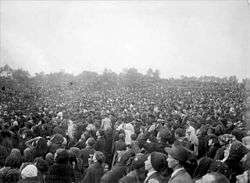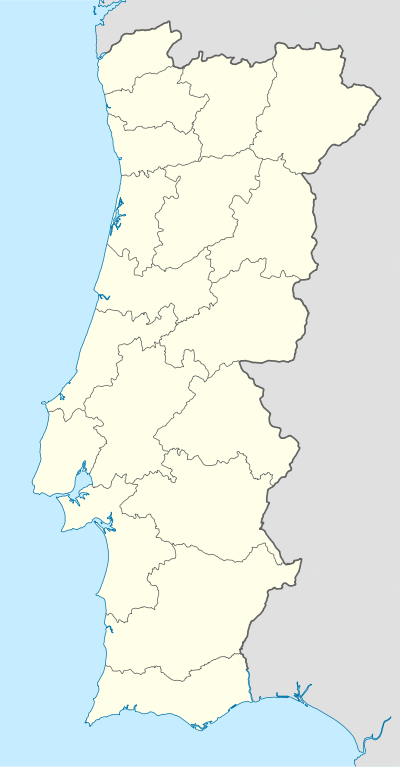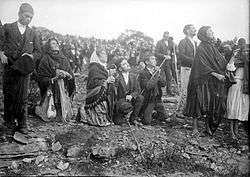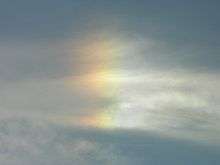Miracle of the Sun
The Miracle of the Sun (Portuguese: O Milagre do Sol) was an event which occurred on 13 October 1917, reportedly attended by 30,000 to 100,000 people gathered near Fátima, Portugal. Several newspaper reporters were in attendance and they took testimony from many people who claimed to have witnessed extraordinary solar activity.
According to these reports, the event lasted approximately ten minutes. The three children (Lúcia dos Santos, Jacinta Marto and Francisco Marto) who originally claimed to have seen Our Lady of Fátima also reported seeing a panorama of visions, including those of Jesus, Our Lady of Sorrows, Our Lady of Mt. Carmel, and of Saint Joseph blessing the people.[1]
The event was officially accepted as a miracle by the Catholic Church on 13 October 1930. On 13 October 1951, the papal legate, Cardinal Tedeschini, told the million people gathered at Fátima that on 30 October, 31 October, 1 November, and 8 November 1950, Pope Pius XII himself witnessed the miracle of the sun from the Vatican gardens.[2][3]
The event

In the fourth edition of her memoirs, written in 1941, Lucia said that on the occasion of their third visit to the Cova da Iria, on July 13, 1917, she asked the lady to tell them who she was, and to perform a miracle so that everyone would believe. The lady told to her that they should continue to come to the Cova each month until October, when the requested miracle would occur.[4]
Estimates of number present range from 30,000 and 40,000 by Avelino de Almeida, writing for the Portuguese newspaper O Século,[5] to 100,000, estimated by Dr. Joseph Garrett, professor of natural sciences at the University of Coimbra,[6] both of whom were present that day.[7]
The people had gathered because three young shepherd children had predicted that at high noon the lady who had appeared to them several times would perform a great miracle. According to many witnesses, after a period of rain, the dark clouds broke and the sun appeared as an opaque, spinning disc in the sky. It was said to be significantly duller than normal, and to cast multicolored lights across the landscape, the people, and the surrounding clouds. The sun was then reported to have careened towards the earth before zig-zagging back to its normal position.[4] Witnesses reported that their previously wet clothes became "suddenly and completely dry, as well as the wet and muddy ground that had been previously soaked because of the rain that had been falling".[8] Not all witnesses reported seeing the sun "dance". Some people only saw the radiant colors, and others, including some believers, saw nothing at all.[9][10][11][12]
The event was attributed by believers to Our Lady of Fátima, a reported apparition of the Blessed Virgin Mary to the children who had made predictions of the event on 13 July 1917,[13] 19 August,[14] and 13 September.[15] The children stated that the Lady had promised them that she would on 13 October reveal her identity to them[16] and provide a miracle "so that all may believe."[17]
De Marchi accounts


The most widely cited descriptions of the events reported at Fatima are taken from the writings of John De Marchi, an Italian Catholic priest and researcher. De Marchi spent seven years in Fátima, from 1943 to 1950, conducting research and interviewing the principals at length.[18] In The Immaculate Heart, published in 1952, De Marchi reports that, "[t]heir ranks (those present on 13 October) included believers and non-believers, pious old ladies and scoffing young men. Hundreds, from these mixed categories, have given formal testimony. Reports do vary; impressions are in minor details confused, but none to our knowledge has directly denied the visible prodigy of the sun."[19]
Some of the witness statements follow below. They are taken from John De Marchi's several books on the matter.
- "The sun, at one moment surrounded with scarlet flame, at another aureoled in yellow and deep purple, seemed to be in an exceedingly swift and whirling movement, at times appearing to be loosened from the sky and to be approaching the earth, strongly radiating heat."―Dr. Domingos Pinto Coelho, writing for the Catholic newspaper Ordem.[20]
- "... The silver sun, enveloped in the same gauzy grey light, was seen to whirl and turn in the circle of broken clouds ... The light turned a beautiful blue, as if it had come through the stained-glass windows of a cathedral, and spread itself over the people who knelt with outstretched hands ... people wept and prayed with uncovered heads, in the presence of a miracle they had awaited. The seconds seemed like hours, so vivid were they."―Reporter for the Lisbon newspaper O Dia.[19]
- "The sun's disc did not remain immobile. This was not the sparkling of a heavenly body, for it spun round on itself in a mad whirl, when suddenly a clamor was heard from all the people. The sun, whirling, seemed to loosen itself from the firmament and advance threateningly upon the earth as if to crush us with its huge fiery weight. The sensation during those moments was terrible."—Dr. Almeida Garrett, Professor of Natural Sciences at Coimbra University.[21]
- "As if like a bolt from the blue, the clouds were wrenched apart, and the sun at its zenith appeared in all its splendor. It began to revolve vertiginously on its axis, like the most magnificent firewheel that could be imagined, taking on all the colors of the rainbow and sending forth multicolored flashes of light, producing the most astounding effect. This sublime and incomparable spectacle, which was repeated three distinct times, lasted for about ten minutes. The immense multitude, overcome by the evidence of such a tremendous prodigy, threw themselves on their knees."―Dr. Manuel Formigão, a professor at the seminary at Santarém, and a priest.[21]
- "I feel incapable of describing what I saw. I looked fixedly at the sun, which seemed pale and did not hurt my eyes. Looking like a ball of snow, revolving on itself, it suddenly seemed to come down in a zig-zag, menacing the earth. Terrified, I ran and hid myself among the people, who were weeping and expecting the end of the world at any moment."—Rev. Joaquim Lourenço, describing his boyhood experience in Alburitel, eighteen kilometers from Fatima.[22]
- "On that day of October 13, 1917, without remembering the predictions of the children, I was enchanted by a remarkable spectacle in the sky of a kind I had never seen before. I saw it from this veranda ..."—Portuguese poet Afonso Lopes Vieira.[23]
- De Marchi also drew on the newspaper account written by Avelino de Almeida, a journalist sent by the newspaper O Século ("The Century"), who described in detail the reactions of the crowd.[24]
According to De Marchi, "Engineers that have studied the case reckoned that an incredible amount of energy would have been necessary to dry up those pools of water that had formed on the field in a few minutes as it was reported by witnesses."[8]
Critical evaluation of the event
Auguste Meessen, following the work done before him by the Belgian skeptic Marc Hallet,[25] has stated sun miracles cannot be taken at face value and that the reported observations were optical effects caused by prolonged staring at the sun. Meessen contends that retinal after-images produced after brief periods of sun gazing are a likely cause of the observed dancing effects. Similarly Meessen states that the color changes witnessed were most likely caused by the bleaching of photosensitive retinal cells.[26] Meessen observes that Sun Miracles have been witnessed in many places where religiously charged pilgrims have been encouraged to stare at the sun. He cites the apparitions at Heroldsbach, Germany (1949) as an example, where many people within a crowd of over 10,000 testified to witnessing similar observations as at Fátima.[26] Meessen also cites a British Journal of Ophthalmology article that discusses some modern examples of Sun Miracles.[27] While Meessen suggests possible psychological or neurological explanations for the apparitions he notes, "It is impossible to provide any direct evidence for or against the supernatural origin of apparitions".[26] He also notes that "[t]here may be some exceptions, but in general, the seers are honestly experiencing what they report." [26]
Critics of Meessen's theory point to the fact that the crowd was not encouraged to look at the sun until the alleged miracle was already underway- the children did not tell the crowd to expect a sun miracle. Additionally, people in towns up to forty kilometers away, who had no knowledge of the alleged supernatural events at Fátima, also reported seeing the phenomenon. The phenomenon may actually have been expected by some – The witness Joaquim Gregorio Tavares testified that "we were there while having in mind conversations we earlier had with cool-headed persons who were anticipating some changes of color in the sun."[28] Madre Maria do Carmo, the daughter of a witness, claimed that in Alburitel it was "anticipated that the miracle would involve the stars", and that in the morning of October 13, "the people of Alburitel were darkening bits of glass by exposing them to candle-smoke so that they might watch the sun, with no harm to their eyes."[29]
Additionally, a few witnesses reported noticing colour changes before or simultaneously with looking at the sun[30][31]. Four witnesses, Carlos Silva,[32] José Maria de Proença de Almeida Garrett,[33][34] Antonio de Paula[35][36] and Manuel Gonçalves Junior,[37] claimed to have looked away from the sun and still seen the landscape change colours. While de Almeida Garrett had been looking at the sun for some time before turning away, Gonçalves testified that "The eyes were fixed at the makeshift gate so that something extraordinary might be seen, and without looking at the sun on purpose, he noted that in the same moment when the people burst out in loud cries and exclamations, because of what was seen in the sun, both the people and the trees and everything within his view directed at that gate, took on different colors."
De Marchi states that the prediction of an unspecified "miracle", the abrupt beginning and end of the alleged miracle of the sun, the varied religious backgrounds of the observers, the sheer numbers of people present, and the lack of any known scientific causative factor make a mass hallucination unlikely.[38] That the activity of the sun was reported as visible by those up to 18 kilometres (11 mi) away, also precludes the theory of a collective hallucination or mass hysteria.[38]
De Marchi cites Pio Scatizzi S.J. who identified two possible alternatives:
The ... solar phenomena were not observed in any observatory. Impossible that they should escape notice of so many astronomers and indeed the other inhabitants of the hemisphere ... there is no question of an astronomical or meteorological event phenomenon ... Either all the observers in Fátima were collectively deceived and erred in their testimony, or we must suppose an extra-natural intervention.[39]
There are two other possible alternatives, that Pio Scatizzi fails to recognize, and these would be that those taking part in the event were either deceived by their senses, or that they were experiencing a local natural phenomenon.[40]
Steuart Campbell, writing for the edition of Journal of Meteorology in 1989, postulated that a cloud of stratospheric dust changed the appearance of the sun on 13 October, making it easy to look at, and causing it to appear to be yellow, blue, and violet, and to spin. In support of his hypothesis, Mr. Campbell reported that a blue and reddened sun was reported in China as documented in 1983.[41]

Joe Nickell notes: "Not surprisingly, perhaps, Sun Miracles have been reported at other Marian sites—at Lubbock, Texas, in 1989; Mother Cabrini Shrine near Denver, Colorado, in 1992; Conyers, Georgia, in the early to mid-1990s".[42] Nickell also suggests that the dancing effects witnessed at Fátima may have been due to optical effects resulting from temporary retinal distortion caused by staring at such an intense light.[42] Nickell, also suggested the cause may have been a sundog.[43] Sometimes referred to as a parhelion or "mock sun", a sundog is a relatively common atmospheric optical phenomenon associated with the reflection and refraction of sunlight by the numerous small ice crystals that make up cirrus clouds or cirrostratus clouds.
Paul Simons, in an article entitled "Weather Secrets of Miracle at Fátima", stated that he believes that it is possible that some of the optical effects at Fátima may have been caused by a cloud of dust from the Sahara.[44]
Kevin McClure claims that the crowd at Cova da Iria may have been expecting to see signs in the sun, since similar phenomena had been reported in the weeks leading up to the miracle. On this basis, he believes that the crowd saw what it wanted to see. However, none of the previous phenomena had to do with the sun; the focus, for the most part, was on the little tree where the lady was said to appear. Kevin McClure stated that he had never seen such a collection of contradictory accounts of a case in any of the research that he had done in the previous ten years, although he has not explicitly stated what these contradictions were.[45]
Leo Madigan, a former psychiatric nurse and local journalist at Fatima in the late 20th century, believes that the various witness reports of a miracle were accurate. However, he alleges inconsistency in the accounts of witnesses, and he suggests that astonishment, fear, exaltation, and imagination must have played roles in both the observing and the retelling. Madigan likens the experiences to prayer, and considers that the spiritual nature of the phenomenon explains what he describes as the inconsistency of the witnesses.[46]
Stanley L. Jaki, a professor of physics at Seton Hall University in New Jersey, a Benedictine priest, and the author of a number of books dealing with the intersection of science and faith, proposed that the event was natural and meteorological in nature, but that the fact the event occurred at the exact time predicted was a miracle.[47]
Media
- In 1996, John Haffert (co-founder of the Blue Army of Our Lady of Fátima) spoke about Fátima and his book "Meet the Witnesses" in which he personally interviewed nearly 200 witnesses to the Fátima Miracle, describing their detailed witness accounts.
- The 2009 movie The 13th Day is a dramatization of the Fátima visions based on the writings of Sister Lúcia dos Santos.[48]
See also
References
- ↑ (De Marchi 1952b:151–166)
- ↑ Joseph Pelletier. (1983). The Sun Danced at Fátima. Doubleday, New York. p. 147–151.
- ↑ Gaspari, Antonio. "Pius XII Saw 'Miracle of the Sun'", Zenit, November 4, 2008
- 1 2 Bennett, Jeffrey S., When the Sun Danced: Myth, Miracles, and Modernity in Early Twentieth-Century Portugal, University of Virginia Press, 2012 ISBN 9780813932507
- ↑ (De Marchi 1952a)
- ↑ (De Marchi 1952a:177)
- ↑ (De Marchi 1952a:185–187)
- 1 2 (De Marchi 1952b:150)
- ↑ Jaki, Stanley L. (1999). God and the Sun at Fátima. Real View Books. p. 170-171, 232. ASIN B0006R7UJ6.
- ↑ Frere Michel de la Sainte Trinite (1989). "Chapter X, appendix II". The Whole Truth About Fátima, Volume I: Science and the Facts. Names Izabel Brandao de Melo, and a few vague or unverifiable accounts.
- ↑ John Haffert (1961). "Meet the Witnesses" (PDF).
- ↑ "Shrine of Our Lady of Fatima - Fatima, Portugal". Retrieved 8 September 2016.
- ↑ (De Marchi 1952b:74)
- ↑ (De Marchi 1952b:107)
- ↑ (De Marchi 1952b:118)
- ↑ (De Marchi 1952b:46)
- ↑ (De Marchi 1952:118)
- ↑ De Marchi, John. True Story of Fatima, Catechetical Guild Educational Society, St. Paul, Minnesota, 1956
- 1 2 (De Marchi 1952b:143)
- ↑ (De Marchi 1952b:147)
- 1 2 (De Marchi 1952b:146)
- ↑ (De Marchi 1952b:149)
- ↑ (De Marchi 1952b:148–9)
- ↑ Araujo, Elbson. "Fatima - The sun miracle", Universo Catolico
- ↑ Hallet, M. (2011) Les apparitions de la Vierge et la critique historique (new expanded edition)
- 1 2 3 4 Auguste Meessen 'Apparitions and Miracles of the Sun' International Forum in Porto "Science, Religion and Conscience" October 23–25, 2003 ISSN 1645-6564
- ↑ Solar retinopathy following religious rituals. M Hope-Ross,S Travers,D Mooney; Br J Ophthalmol 1988;72:931-934 doi:10.1136/bjo.72.12.931
- ↑ Jaki, Stanley L. (1999). God and the Sun at Fátima. Real View Books. p. 92. ASIN B0006R7UJ6.
- ↑ Jaki, Stanley L. (1999). God and the Sun at Fátima. p. 293.
- ↑ John Haffert (1961). "Meet the Witnesses" (PDF).
- ↑ Jaki, Stanley L. (1999). God and the Sun at Fátima. Real View Books. p. 173. ASIN B0006R7UJ6.
- ↑ Jaki, Stanley L. (1999). God and the Sun at Fátima. Real View Books. p. 70. ASIN B0006R7UJ6.
- ↑ Jaki, Stanley L. (1999). God and the Sun at Fátima. Real View Books. p. 135–136. ASIN B0006R7UJ6.
- ↑ De Marchi, John (1956). "Our Lady appears". The True Story of Fátima. St. Paul Minnesota: Catechetical Guild Educational Society. OCLC 40630767.
- ↑ Barthas, C. (1999). La Virgen de Fátima. p. 124. ISBN 8432132446.
- ↑ Frere Michel de la Sainte Trinite (1989). "Endnotes, #412". The Whole Truth About Fátima, Volume I: Science and the Facts.
- ↑ Jaki, Stanley L. (1999). God and the Sun at Fátima. Real View Books. p. 152. ASIN B0006R7UJ6.
- 1 2 (De Marchi 1952b:150, 278–82)
- ↑ (De Marchi 1952b:282)
- ↑ "The Lady of Fátima & the Miracle of the Sun". LiveScience.com. Retrieved 2015-10-20.
- ↑ "Fátima's dusty veil", New Humanist, Vol 104, No 2, August 1989 and "The Miracle of the Sun at Fátima", Journal of Meteorology, UK, Vol 14, no. 142, October, 1989
- 1 2 Skeptical Inquirer — Volume 33.6 November / December 2009
- ↑ Joe Nickell (1993) Looking for a Miracle: Weeping Icons, Relics, Stigmata, Visions, and Healing Cures Prometheus, ISBN 0-87975-840-6
- ↑ "Weather Secrets of Miracle at Fátima", Paul Simons, The Times, February 17, 2005.
- ↑ Kevin McClure (1983) The Evidence for Visions of the Virgin Mary Aquarian Press, ISBN 0-85030-351-6
- ↑ Leo Madigan (2003), The Children of Fátima Our Sunday Visitor Inc., ISBN 1-931709-57-2
- ↑ Jaki, Stanley L. (1999). God and the Sun at Fátima. Real View Books. ASIN B0006R7UJ6.
- ↑ The 13th Day (Video 2009) at the Internet Movie Database Youtube Video
Bibliography
- De Marchi, John (1956). The True Story of Fátima. St. Paul Minnesota: Catechetical Guild Educational Society. OCLC 40630767.
- De Marchi, John (1952b). The Immaculate Heart, The True Story of Our Lady of Fatima. New York: Farrar, Straus and Young. OCLC 2947238.
External links
- Newspaper article in Portuguese that came out shortly after the miracle.
- Picture of the sun during the alleged miracle. (archive)
- Apparitions and Miracles of the Sun
- Phil Plait. "When self-fulfilling prophecies Knock", Discover Magazine
- BBC News article on sun miracles at Knock
- The Fatima Message
